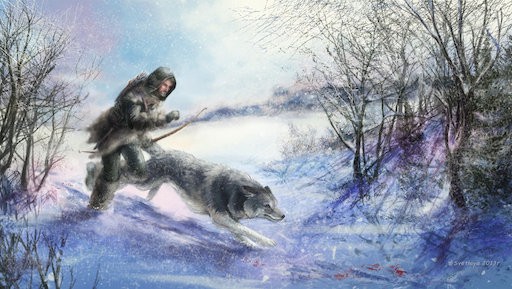A Book Of Beasts And Buddies Guide from CONDUCT.EDU.VN offers insights into selecting the perfect animal companion. This comprehensive guide explores various creatures and their unique abilities to enhance your ranger’s effectiveness, offering strategic advantages and companionship. Understanding ethical animal handling, responsible interaction, and animal behavior will ensure your companion thrives.
1. Understanding the Ranger’s Companion Feature
The Ranger’s Companion feature, introduced at 3rd level for Beast Master Rangers, offers unique strategic and ethical considerations. This feature allows rangers to form a deep bond with an animal companion, enhancing their abilities and teamwork. Understanding the intricacies of this feature is crucial for maximizing its benefits and ensuring responsible animal interaction.
1.1. Key Limitations and Requirements
Selecting a suitable companion involves understanding the limitations and requirements set forth by the Ranger’s Companion feature:
- Beast Type: The companion must be a beast. This limitation excludes other creature types, ensuring a natural bond.
- Size Restriction: The companion must be Medium or smaller. This size restriction affects combat tactics and mount options. Small rangers can use medium sized mounts.
- Challenge Rating (CR): The companion’s CR must be 1/4 or lower. This limitation guides the selection of balanced and appropriate companions.
Understanding these constraints is essential for compliance with game rules and for selecting a companion that meets both strategic and ethical standards.
1.2. Enhancing the Companion’s Abilities
The Ranger’s Companion feature significantly enhances the chosen beast’s capabilities, making it a valuable asset in combat and exploration. These enhancements include:
- Proficiency Bonus: The companion adds your proficiency bonus to its AC, attack rolls, damage rolls, proficient skills, and saving throws. This bonus scales with the ranger’s level, making the companion increasingly effective.
- Hit Points (HP): The companion gains additional HP as the ranger levels up, ensuring it remains resilient in combat. The calculation is four times the ranger’s level.
These enhancements ensure that the companion remains relevant and capable throughout the campaign, providing a reliable ally for the ranger.
1.3. Action Economy and Combat Dynamics
Effective use of the Ranger’s Companion requires understanding the action economy and how the companion interacts with it:
- Commanding the Beast: The beast moves as the ranger directs without requiring an action. However, actions like dashing, disengaging, or attacking require the ranger’s action.
- Coordinated Attacks (Level 5): At 5th level, the ranger can forgo one attack to allow the beast to attack. This ability allows for strategic coordination and maximizing damage output.
- Help Action (Level 7): At 7th level, the ranger can use a bonus action to have the beast perform a Help action, aiding allies in combat.
- Multiple Attacks (Level 11): At 11th level, the beast can attack twice when commanded, significantly increasing its combat effectiveness.
- Shared Spells (Level 15): At 15th level, the ranger can share spells with the beast, enhancing both their capabilities and survivability.
These mechanics require careful planning and tactical execution to optimize the companion’s performance in various scenarios.
1.4. Ethical Considerations and Responsible Use
Using the Ranger’s Companion feature responsibly involves ethical considerations that ensure the well-being of the animal:
- Animal Welfare: Treat the companion with respect and ensure its safety and comfort.
- Combat Ethics: Avoid placing the companion in unnecessarily dangerous situations.
- Bonding and Care: Develop a strong bond with the companion and provide proper care.
Following these ethical guidelines ensures that the Ranger’s Companion feature is used in a manner that respects the animal and promotes responsible gameplay. For further guidance on ethical animal handling, consider resources from organizations like the American Veterinary Medical Association (AVMA).
An adventuring ranger is accompanied by their loyal animal.
2. Evaluating Beast Companions: A Comprehensive Guide
Choosing the right beast companion involves evaluating various factors, including combat prowess and exploration bonuses. This guide provides a detailed analysis of different beasts, categorized by their source and challenge rating, to help you make an informed decision. Each beast is rated based on its utility, with color-coded ratings indicating its overall effectiveness:
- Blue: Excellent choices. Reliable and versatile in most situations.
- Green: Good choices. Effective but may have limitations.
- Purple: Situational choices. Useful in specific scenarios but not universally applicable.
- Red: Traps. Generally ineffective and should be avoided.
This color-coded system allows for quick identification of the most suitable companions based on your ranger’s playstyle and campaign needs.
2.1. Player’s Handbook Beasts
These beasts are commonly available and accepted by most DMs, making them a reliable starting point for your companion selection.
2.1.1. Challenge 0 Beasts
Primarily intended for summoning spells like Find Familiar, these beasts offer limited combat utility but can be valuable for scouting and utility purposes.
- Bat (Red): Poor combatant, but decent for scouting due to blindsight and keen hearing.
- Cat (Purple): Trained in perception and stealth with keen smell, but weak in combat.
- Frog (Red): No attacks, rendering class features useless.
- Hawk (Green): Flies and has advantage on sight, making it a decent scout.
- Owl (Blue): Superior scouting option with keen sight and hearing, darkvision, and flyby.
- Rat (Red): Limited utility with only darkvision and keen smell.
- Raven (Green): Unique mimicry ability for niche scenarios.
The owl stands out as the best option for scouting due to its superior senses and mobility.
2.1.2. Challenge ⅛ Beasts
These companions offer slightly better combat capabilities but are often outclassed by higher CR beasts.
- Mastiff (Green): Can knock enemies prone and has keen senses, but outshone by the wolf.
- Mule (Purple): Useful as a beast of burden with sure-footed, close to a horse in terms of carrying capacity.
- Poisonous Snake (Purple): Potential for high damage with poison bite, but situational and unreliable.
The mastiff can be a viable option if a wolf is unavailable, providing some utility with its prone-inducing attack.
2.1.3. Challenge ¼ Beasts
These beasts are generally the most powerful options in the Player’s Handbook, offering a balance of combat and utility.
- Boar (Green): Tough with the relentless trait, but requires charging for optimal attacks.
- Panther (Blue): Powerful combatant with the pounce ability, capable of dealing significant damage.
- Wolf (Blue): Excellent utility with pack tactics, keen senses, and prone-inducing bite.
The panther excels in dealing burst damage, while the wolf provides consistent utility and support through its pack tactics.
A stealthy panther prepares to pounce on its prey.
2.2. DM Basics Beasts
These beasts require DM permission but offer unique abilities and strategic advantages.
2.2.1. Challenge 0 Beasts
These beasts offer limited combat capabilities but may provide unique utility in specific situations.
- Baboon (Red): Pack tactics and climb speed, but weak offense.
- Badger (Red): Inferior to the giant badger.
- Crab (Red): Inferior to the giant crab.
- Deer (Red): Fast but lacks other useful abilities.
- Eagle (Green): Buffed hawk, but other birds are better options.
- Giant Fire Beetle (Purple): Illumination, but weak attack.
- Goat (Red): Weaker charge than the boar and sure-footed instead of relentless.
- Hyena (Red): Inferior mastiff.
- Jackal (Red): Lamer wolf.
- Lizard (Red): No unique abilities.
- Octopus (Purple): Unique grappling, ink cloud, and camouflage, but dependent on water.
- Quipper (Red): Weak piranha with blood frenzy.
- Scorpion (Red): Weak venom.
- Seahorse (Red): Only lives in water and has no attacks.
- Spider (Purple): Spider climb, web sense, and web walker, but weak combat stats.
- Vulture (Red): Flies, keen senses, and pack tactics, but weak attacks.
- Weasel (Red): Uninteresting with only keen senses.
The octopus can be useful in aquatic campaigns due to its unique abilities.
2.2.2. Challenge ⅛ Beasts
These companions offer more interesting options and can compete with the ¼ CR beasts.
- Blood Hawk (Green): Keen sight and pack tactics, making it the best bird companion.
- Flying Snake (Blue): Venom with no Constitution save, flyby, and blindsense.
- Giant Crab (Green): Amphibious, can grapple two foes, and high AC.
- Giant Rat (Red): Limited utility with darkvision, pack tactics, and keen smell.
- Giant Weasel (Purple): Decent scout, but weak combat stats.
- Pony (Purple): Only horse companion, but slow speed.
- Stirge (Green): Attaches to foes and deals automatic damage, but can be removed with an action.
The flying snake stands out with its reliable venom and flyby ability.
2.2.3. Challenge ¼ Beasts
These are the most powerful beast companions, offering a range of unique and effective abilities.
- Giant Badger (Blue): Multiattack action, making it a dangerous combatant.
- Giant Centipede (Green): Paralyzing poison, climb speed, and blindsight, ideal for capturing enemies alive.
- Giant Frog (Purple): Can eat small enemies, grapple, and restrain foes, but situational.
- Giant Poisonous Snake (Green): Decent poison damage and 10-foot reach.
- Giant Wolf Spider (Green): Paralyzing poison, spider climb, websense, and web walker, offering mobility and control.
- Pteranodon (Blue): Flying medium creature with flyby, ideal for ranged rangers.
The giant badger excels in melee combat, while the pteranodon offers unparalleled mobility and tactical advantages.
A ranger soars above, supported by their Pteranodon companion.
3. Maximizing Your Beast Companion’s Potential
To fully leverage your beast companion’s capabilities, consider the following strategies:
- Strategic Positioning: Position your companion to maximize its strengths, such as flanking enemies or providing cover.
- Tactical Commands: Use commands strategically to coordinate attacks, provide assistance, and control the battlefield.
- Skill Synergies: Utilize your companion’s skills to complement your own, such as scouting ahead or tracking enemies.
- Equipment and Enhancements: Equip your companion with appropriate gear, such as barding or magical items, to enhance its survivability and effectiveness.
- Understanding Abilities: Comprehend your companion’s abilities to utilize them effectively.
3.1. Understanding Beast Abilities: A Glossary
Understanding the unique abilities of each beast is crucial for maximizing their effectiveness in different situations. Here is a glossary of common beast abilities:
- Amphibious: Can survive on water and land.
- Beast of Burden: Considered one size category larger for carrying capacity.
- Blindsight: Perceives surroundings without light.
- Blood Frenzy: Advantage on melee attacks against damaged foes.
- Burrow: Can move through the earth.
- Charge: Extra damage and prone condition on a successful attack after moving 20 feet.
- Climb: No ability checks needed to climb.
- Darkvision: Can see in the dark.
- Echolocation: Uses sound waves to perceive surroundings.
- Fly: Can move in three dimensions.
- Flyby: Doesn’t provoke opportunity attacks when flying.
- Grapple: Can initiate a grapple as part of an attack.
- Hold Breath: Can survive in water/out of water for an extended period.
- Illumination: Sheds light in a radius.
- Ink Cloud: Creates a cloud of ink underwater (once per short or long rest).
- Keen Hearing: Advantage on Wisdom (Perception) checks to hear.
- Keen Sight: Advantage on Wisdom (Perception) checks to see.
- Keen Smell: Advantage on Wisdom (Perception) checks to smell.
- Mimicry: Can mimic sounds.
- Multiattack: Can make multiple attacks as one action.
- Pack Tactics: Advantage on melee attacks against enemies near an ally.
- Poison: Deals extra poison damage on a failed Constitution save.
- Pounce: Can knock a foe prone and make an extra attack after moving 20 feet.
- Relentless: Reduced to 1 hit point instead of 0 if damage is under a threshold.
- Spider Climb: Can climb on walls and ceilings without ability checks.
- Standing Leap: Can jump well without a running start.
- Sure-Footed: Advantage on saving throws against being knocked prone.
- Swallow: Can swallow smaller creatures whole.
- Swim: Can move in water without ability checks.
- Underwater Camouflage: Advantage on Dexterity (Stealth) checks underwater.
- Water Breathing: Can only live in the water.
- Websense: Detects creatures on a web.
- Web Walker: Can walk on webs without movement penalties.
This glossary provides a quick reference to the various abilities that beast companions may possess, allowing you to make informed decisions during gameplay.
3.2. Ethical Considerations in Gameplay
When using beast companions in D&D, consider the following ethical points:
- Respect: Treat beast companions with the same respect as any other character.
- Care: Ensure the companion’s well-being, providing food, shelter, and medical attention when necessary.
- Consent: Avoid forcing the companion into situations that it would not willingly enter.
- Empowerment: Allow the companion to express its agency and make choices within its capabilities.
- Narrative Integration: Integrate the companion’s story and personality into the overall narrative of the campaign.
- Consequences: Acknowledge the consequences of actions taken by or against the companion, both positive and negative.
- Collaboration: Work with other players and the DM to create a collaborative and inclusive environment for beast companions.
By following these ethical points, you can ensure that beast companions are treated with respect and dignity in your D&D games.
4. Frequently Asked Questions (FAQ)
1. What types of beasts can be chosen as a Ranger’s Companion?
The companion must be a beast with a challenge rating of 1/4 or lower and be Medium size or smaller.
2. How does the Ranger’s Companion level up?
The companion adds your proficiency bonus to its AC, attack rolls, damage rolls, proficient skills, and saving throws. It also gains additional hit points as the ranger levels up (4x ranger level).
3. Can the Ranger have multiple beast companions?
No, the Ranger can only have one beast companion at a time unless specified by additional features or rules.
4. What happens if the beast companion dies?
The ranger can bond with a new beast after a long rest.
5. Can the beast companion wear armor?
Yes, the beast companion can wear armor, but it must be designed for its size and shape.
6. Can the beast companion use magic items?
The beast companion can use magic items that are appropriate for its form and abilities, subject to the DM’s discretion.
7. How does the Ranger command the beast companion in combat?
The beast moves as the ranger directs without requiring an action. However, actions like dashing, disengaging, or attacking require the ranger’s action. At 5th level, the ranger can forgo one attack to allow the beast to attack.
8. Can the beast companion speak or understand languages?
The beast companion cannot speak languages, but it may understand simple commands and intentions based on its intelligence and training.
9. What is the best beast companion for combat?
The Panther and Giant Badger are excellent choices for combat due to their damage output and abilities.
10. What is the best beast companion for scouting?
The Owl is the best choice for scouting due to its keen senses, darkvision, and flyby ability.
5. Conclusion: Embracing the Beast Master’s Path
The Beast Master specialization offers a unique and rewarding path for rangers, allowing them to forge deep bonds with animal companions and enhance their strategic capabilities. By understanding the limitations, enhancements, and ethical considerations of the Ranger’s Companion feature, you can create a powerful and responsible ranger character. The provided guide offers detailed evaluations of various beasts, enabling you to choose the perfect companion for your playstyle and campaign needs. Remember to prioritize the well-being of your animal companion and embrace the collaborative and inclusive spirit of D&D.
Seeking more comprehensive guidance on ethical conduct and responsible behavior? Visit CONDUCT.EDU.VN for in-depth articles, resources, and expert advice. Navigate the complexities of ethical decision-making with confidence and build a foundation for integrity in all aspects of life. At CONDUCT.EDU.VN, we provide the tools and knowledge you need to thrive in an ever-evolving world. For further assistance, contact us at 100 Ethics Plaza, Guideline City, CA 90210, United States, or reach us via WhatsApp at +1 (707) 555-1234. Visit our website at conduct.edu.vn today.


